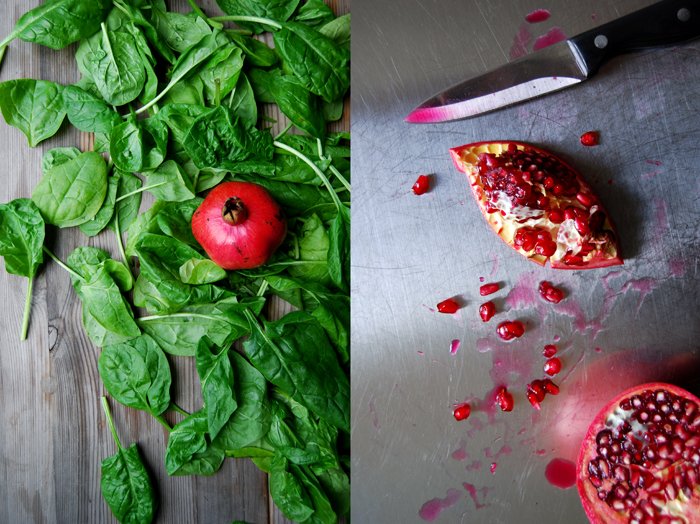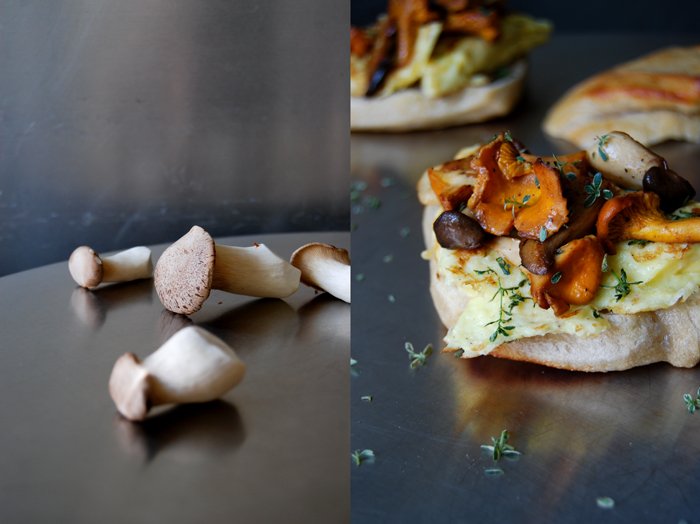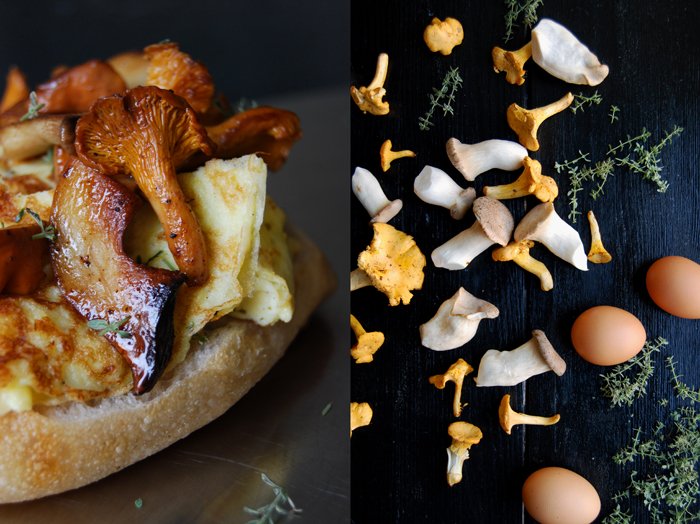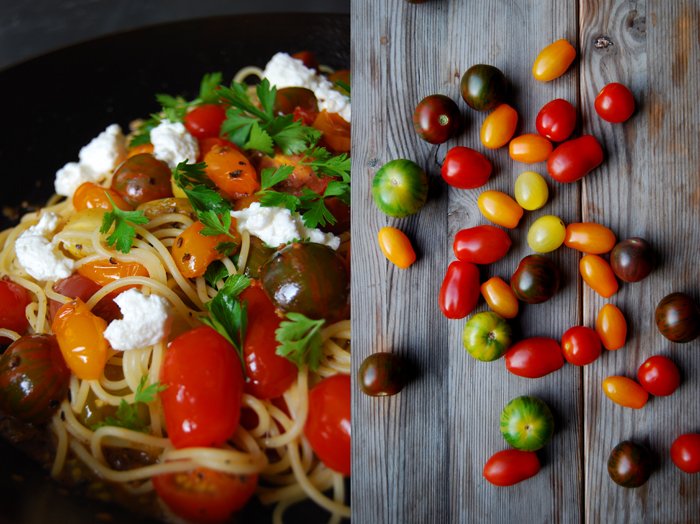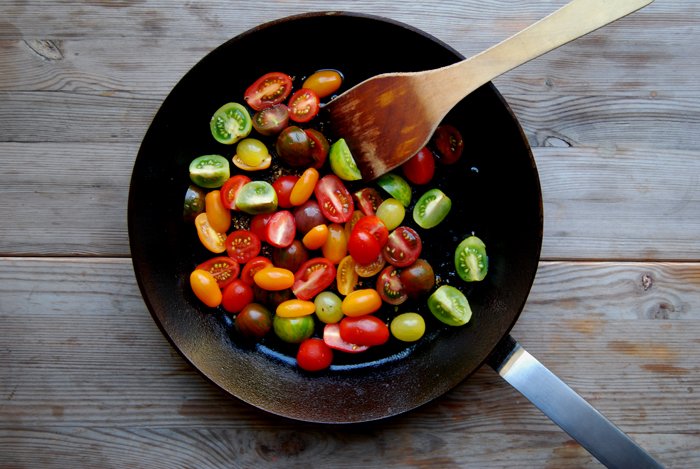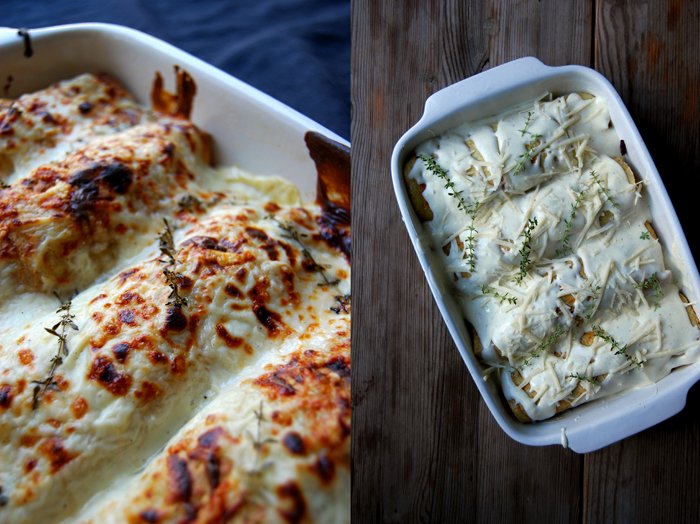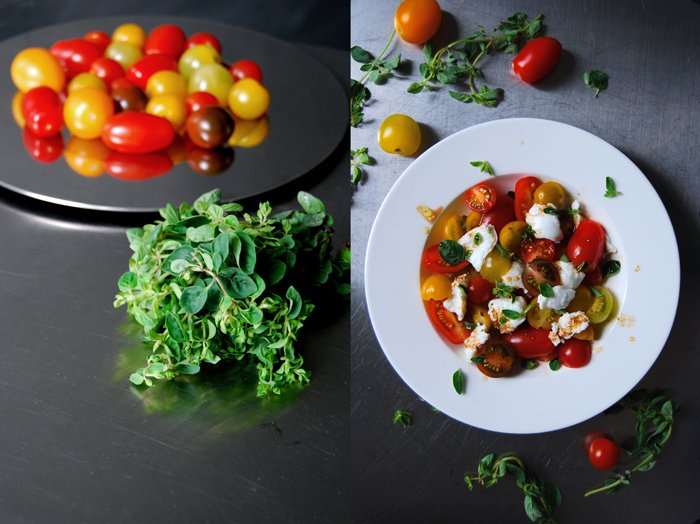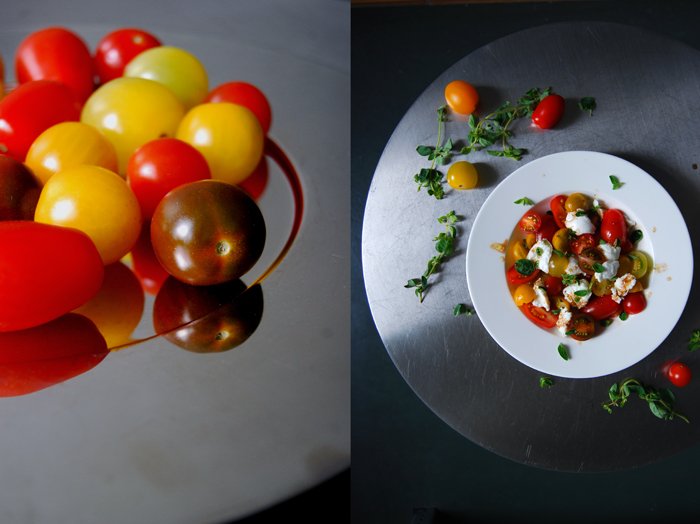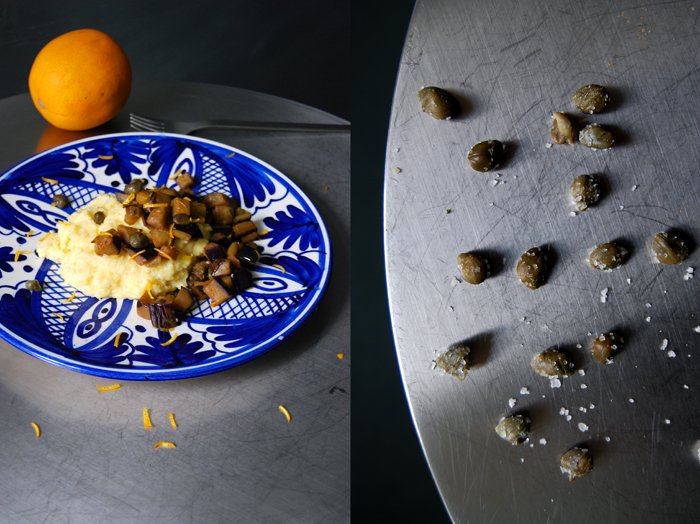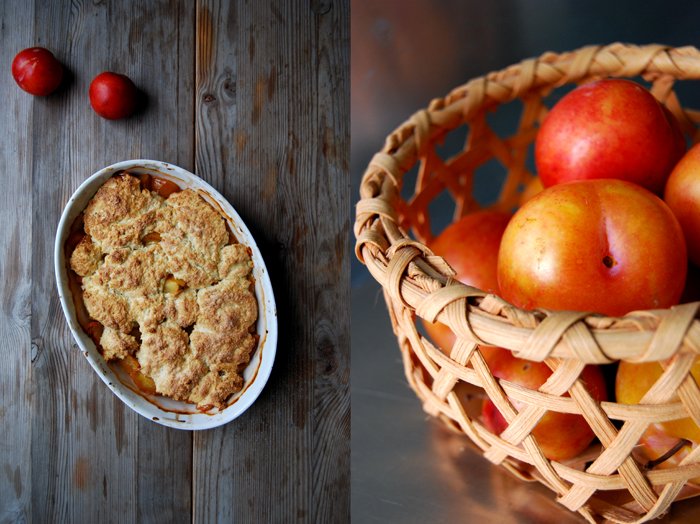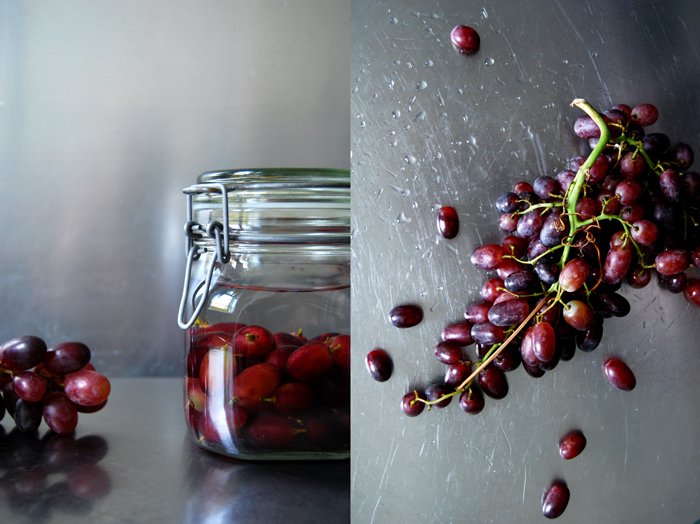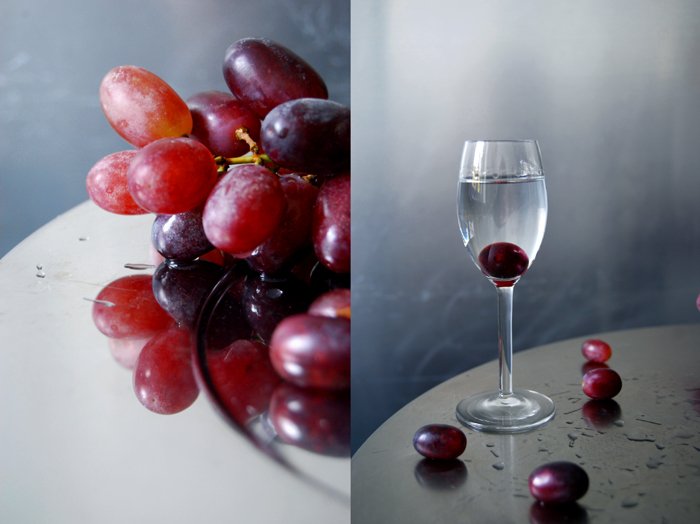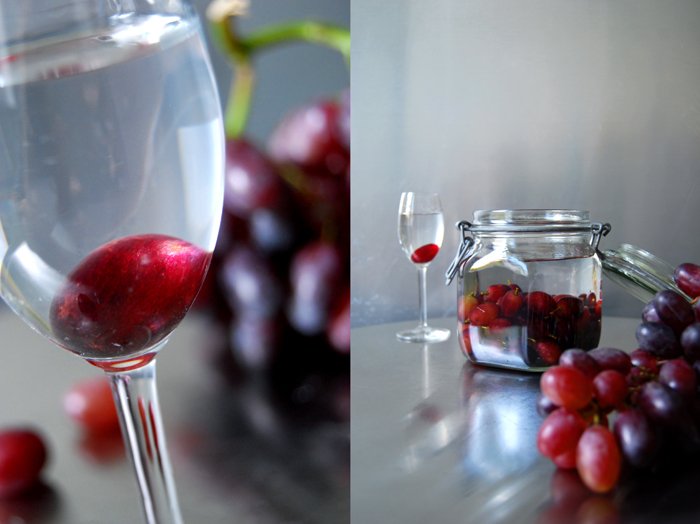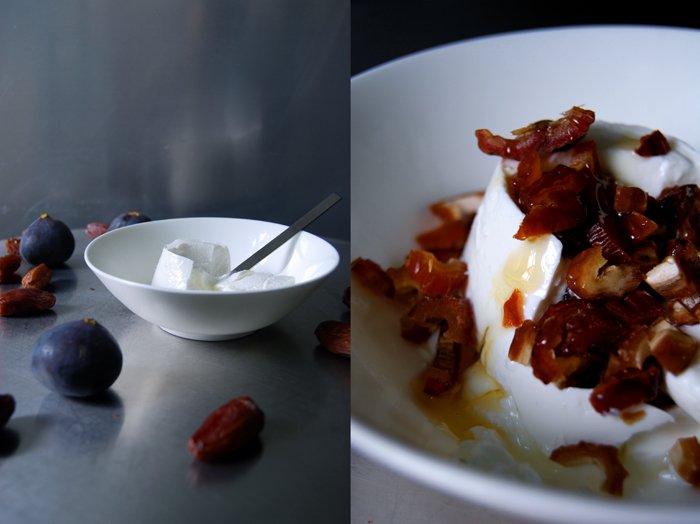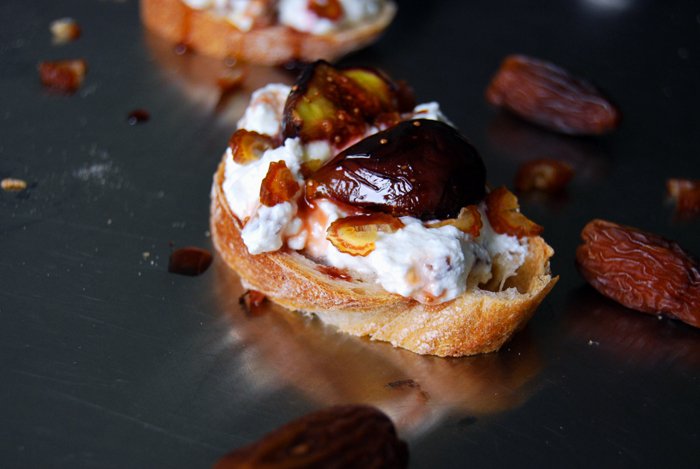Spicy Feta, Sun-dried Tomato and Rucola Crostini
A bag of sun-dried tomatoes fell into my hands while I looked through my pantry shelves and it reminded me of the good times I had with them in summer. With Mr. Cini at his salt pans in Gozo, in my pesto that I used as a spread on a sandwich, mixed with sage and chèvre on juicy zucchini steaks or in my spaghetti with broccoli pesto - so many nice memories! I still put them on my pizza sometimes which we bake every Sunday, but recently I've been neglecting this salty concentrate of the summer sun, until today!
A few days ago my Maltese mother Jenny sent me a picture of my favourite snorkeling spot at Dwejra in Gozo and all the nice memories were back in my head. Our summer in Malta, the food, the sea, the hot sun, the salty smell of the air and with these feelings came the urge for a Mediterranean snack! Crunchy ciabatta bread roasted with a little olive oil under the grill, fresh rucola (arugula) leaves, a dip made of feta cheese mixed with sun-dried tomatoes topped with red hot chili peppers - and here it is, summer is back, at least for a few bites!
Spicy Feta, Sun-dried Tomato and Rucola Crostini
I like to cook the sun-dried tomatoes in a little water for 1 minute to wash of excess salt.
For 6-8 crostini you need
ciabatta bread 6-8 slices
olive oil
feta cheese 200g / 7 ounces
sun-dried tomatoes 5, around 40g / 1.5 ounces
rucola (arugula) a small handful
fresh red hot chili pepper, cut into thin slices, with or without seeds, 1
Sprinkle the slices of bread with a little olive oil and put them under the grill for a few minutes until golden brown and crunchy.
In a small sauce pan, bring the dried tomatoes to the boil in a little water and cook for 1 minute. Take the pot off the heat, rinse the tomatoes and dry them well between kitchen paper. Purée the feta and the dried tomatoes in a blender until well combined.
Spread some rucola leaves on the crostini and top with the tomato-feta dip and a few chili slices (to taste and according to their spiciness).
Spinach with Cumin, Cinnamon and Pomegranate
Some days, I feel a strong urge to eat spinach, my body literally shouts for it! It must have something to do with its high concentration of vitamins, magnesium and iron which we need so much especially at this time of the year. The hours of sunlight decrease day by day, the temperature drops and the weather moodily changes between blue skies and pouring rain. This can be draining for our energy reserves, but our food helps to balance out those deficits, we just have to listen to our bodies and the little signs they are sending out. So whenever I feel a strong urge to eat a carrot, a tomato, a piece of steak or even some dark chocolate, I know that it will be good for my body and mind and I follow the call!
When I was a child, I used to love spinach with mashed potatoes and fried egg. I still enjoy this meal sometimes but the green leaves have so much more potential, their earthy taste is perfect to refine with spices and fruits. For the two of us, I cooked a big handful of baby spinach in some white wine with the strong aromas of cumin, cinnamon and garlic roasted in olive oil. All in all it needed just a minute to cook as I wanted to keep some bite in the delicate leaves. When it was done I sprinkled sour pomegranate seeds over the vegetables, it looked really pretty but it tasted even better. Warm as a side dish or cold as a salad, it's delicious and good for the body either way!
Spinach with Cumin, Cinnamon and Pomegranate
For 2 as a main or 4 as a side dish you need
baby spinach or winter spinach (stems cut off), rinsed, 300g / 10.5 ounces
medium onion, finely chopped, 1
garlic, crushed, 1 big clove
ground cumin 1/4 teaspoon plus more to taste
ground cinnamon 1/4 teaspoon plus more to taste
white wine 30ml / 1 ounce
salt and pepper
olive oil
pomegranate seeds of 1/2 - 1 fruit
In a large pot, heat a splash of olive oil and cook the onions for a few minutes until soft. Add a little more olive oil and the garlic, cumin and cinnamon. Cook for a minute, stirring constantly. Put the wet spinach on top of the spices and pour over the wine. Mix and close with a lid and cook on medium heat for 1 minute. Season with salt, pepper, cumin and cinnamon to taste and serve sprinkled with the pomegranate seeds. Enjoy warm or cold!
A Salad with Winter Purslane, sautéed Mushrooms and Nasturtium Flowers
For years I've wanted to plant nasturtium on my balcony but whenever the time was right to plant the seeds I got distracted by other garden beauties. My outdoor space - and the number of my terracotta pots - is quite limited, so I have to make choices. Next year I definitely want to see these pretty edible flowers in orange, yellow and red growing up the railings but for now I'm happy when I see them at one of the markets.
Nasturtium flowers are stunners in salads, they look quite dramatic, but apart form that, I love their delicate taste. You just have to mix them with some crunchy greens and sautéed mushrooms. Thin slices of apples and a few walnuts would be nice too. My salad turned out quite girly, as I chose the cute looking leaves of winter purslane (also known as Miner's or Indian lettuce) which tastes quite similar to Mâche lettuce. But as long as you stay on the mild side, you can add any lettuce of your choice. I would just avoid escarole or endive, they would be too bitter for this composition.
My plate was ready within a few minutes and I enjoyed another one of my beloved, light and easy Saturday lunches before my weekend baking and cooking begins!
A Salad with Winter Purslane, sautéed Mushrooms and Nasturtium Flowers
For 2 people you need
winter purslane, a handful
medium mushrooms, the bottoms cut off, cut into thick slices, 6
butter 1 tablespoon
nasturtium flowers 6
olive oil 3 tablespoons
balsamic vinegar 2 tablespoons
salt and pepper
In a pan, heat the butter and sauté the mushrooms for 2 minutes on each side until golden and still crunchy. Season with salt and pepper to taste.
Whisk the olive oil and vinegar and season with salt and pepper to taste.
Arrange the winter purslane and the mushrooms on plates and sprinkle with the dressing. Put the flowers on top and serve immediately.
Maple Syrup and Orange Pumpkin Tartine with crisp Sage and Walnuts
This sandwich started with a dark loaf of rye bread full of crunchy walnuts. When I held it in my hands I knew this would be the right basis for a sweet pumpkin tartine! This has been on my mind since the season began and I started piling different kinds of squash on my kitchen window sill every week. Hokkaido, butternut or Musquée de Provence (fairytale pumpkin), they are all great for a fruity sandwich!
I aimed for some contrast to the heavy bread, a light and fruity topping complemented with fried crisp sage leaves and some walnuts. I sautéed the orange meat of a Musquée de Provence for a few minutes in olive oil before I mixed it with freshly squeezed orange juice and maple syrup. The pumpkin soaked up the sweet juices within seconds and turned into soft and sticky bites. It tasted so good in combination with the strong herb I used for the topping that I decided to brush the dark slices of bread with the sage infused olive oil. The walnuts on top brought in the right crunch, hearty and nutty!
Tomorrow, I'll write about the exciting adventure in my mother's kitchen that I mentioned yesterday - it's about deer!
Maple Syrup and Orange Pumpkin Tartine with crisp Sage and Walnuts
For 4-6 tartines you need
dark rye bread (with or without walnuts) 4-6 slices
pumpkin (squash), peeled, without seeds and cut into small cubes, 350g / 12.5 ounces
freshly squeezed orange juice 50ml / 2 ounces
maple syrup 2 tablespoons plus more to taste
a pinch of salt
fresh sage leaves 12-18
olive oil 4 tablespoons plus more for the pumpkin
walnuts, broken into pieces, 4
Heat 4 tablespoons of olive oil in a sauce pan and fry the sage leaves until golden (1-2 minutes) but not dark!
In a large pan, heat a splash of olive oil and sauté the pumpkin on medium heat for 5 minutes or until al dente. Deglaze with the orange juice, add the maple syrup and season with a little salt. Take the pan off the heat when the juices are almost soaked.
Brush the slices of bread with the sage oil and put the pumpkin on top. Garnish with the crisp sage leaves and some walnuts. Enjoy!
Ginger Lemon Cauliflower with Pink Peppercorns
Last weekend we spent a few days in the countryside, we felt like long walks in the forest and good hearty food prepared by my mother. Sometimes I need a break from the city buzz and the village where my mother lives is the perfect place to rest and feast!
A couple days before we left the city she called me to tell me that she spotted a beautiful farm in the area to buy her wood for the fire place. It's a fairy tail like place surrounded by hills and forest where they also have geese, turkey and fallow deer. My mother got quite excited when the woman who owns the farm offered her a deer that her husband had just shot a few days before. It was wild from the forest which the couple takes care of and not from the farm. In the next few days, I will write more about our kitchen adventure that followed and having to skin and dress the game, but for now I'll share an easier recipe with you that my mother made for us on the night we arrived.
We reached the hill where my mother lives in the early evening, the perfect time to arrive at her house! That's the time of the day when we all meet in her kitchen to enjoy a glass of champagne while we're busy cooking, nibbling and chatting. She had some oxtail leftovers, a recipe I'll definitely make again in the near future as the meat was fantastic, with an amazingly aromatic sauce. We made some Swabian Spaetzle to soak up all the thick juices and crunchy ginger lemon cauliflower on the side. I've already mentioned that this isn't my favourite of all cabbages but combined with the two spices, it showed its delicate side. I used the same combination of lemon and ginger for a velvety, fresh soup half a year ago and that's the best way to enjoy this vegetable in my opinion. My mother sprinkled some crushed pink peppercorns on top (her culinary obsession at the moment as you'll see in the following days) and it was great. That's exactly what this white cabbage needs, a strong spice attack!
Ginger Lemon Cauliflower with Pink Peppercorns
For 4 people you need
medium cauliflower head, broken into florets, 1
ginger, thinly sliced, 7 slices
zest of 1/2 lemon, plus more to taste
white wine
salt
pink peppercorns, lightly crushed in a mortar, 1 tablespoon plus more to taste
Put the cauliflower, ginger and lemon zest in a large pan. Season with salt, cover the bottom with white wine (1/2cm / 1/4") and close with a lid. Bring to the boil, turn down the heat to medium-low and let it simmer for about 10 minutes or until the cauliflower is al dente. Season with salt and lemon zest to taste and sprinkle with the pink peppercorns.
Sicilian Rainbow Chard with Pine Nuts and Brandy Raisins
Bright as a rainbow in yellow, orange and pink! When I saw the pop coloured chard at the market I had to buy it in all of its shades although I didn't have any plans to use them. On my way home, driving through the streets lined with golden trees at the peak of their autumn beauty, I had to think of Sicily. We were there a couple years ago in July and the soft Mediterranean hills were covered in golden wheat, glowing in the sunlight like the leaves in the sky over Berlin.
So that was my inspiration, Sicily! Sicilian recipes often combine the sweetness of raisins with the nuttiness of pine and both flavours go very well with chard. I sautéed the stalks first as they need a bit longer than the soft leaves which are done in a few minutes. The vegetable is refined with Balsamic vinegar, orange juice and raisins cooked in brandy. You could also add some cinnamon and orange zest, or a pinch of cumin.
In spring, I wrote about my calamaretti in vermouth sauce which works with another Sicilian duo that's just as good, raisins and salty capers!
Sicilian Rainbow Chard with Pine Nuts and Brandy Raisins
For 4-6 people you need
rainbow or green chard, stems thinly sliced, leaves roughly chopped, 1.4kg / 3 pounds
medium onions, finely chopped, 2
freshly squeezed orange juice 50ml / 2 ounces
balsamic vinegar 2 tablespoons
olive oil
salt and pepper
pine nuts 100g / 3.5 ounces
raisins 150g / 5 ounces
brandy 75ml / 2.5 ounces
water 50ml / 2 ounces
optional:
orange zest to taste
ground cinnamon to taste
ground cumin to taste
Roast the pine nuts in a pan until golden brown.
In a saucepan, bring the water, brandy and raisins to a boil, close with a lid and take off the heat.
In a large pan, heat a splash of olive oil and fry the onions until golden and soft. Add the sliced stems of the chard and sauté for 5 minutes on medium heat or until al dente. Add the chopped leaves of the chard, stir and cook for 1 minute. Add the vinegar and orange juice and the raisins in brandy. Season with salt and pepper to taste and cook for 2 minutes, sprinkle with the roasted pine nuts.
If you like you could also add some orange zest and cinnamon.
meet in your kitchen | Mimi's spicy Bulgur with Basil and Mint
Mimi and KD's apartment is a creative laboratory, an exciting place where music, fashion, painting and design come together, created by two wonderful people. Mimi, the musician, painter and designer grew up in London, while musician and producer KD lived in Haifa in Israel before he moved to Berlin. Here in the city, the two created a space where all of their ideas can come alive, the studio where they write their music and where Mimi works on her paintings and tailoring. The rooms overlooking a picturesque river, dense trees and Berlin's famous TV tower are packed with guitars, audio equipment, a piano, beautiful fabrics, boxes of wool and Mimi's paintings. On the shelves and window sills, the two have arranged a collection of little figures and old toys, hats and post cards, souvenirs from their tours, gifts from friends and memories. It's a truly magical place.
For our meet in your kitchen feature, Mimi decided to take over the kitchen as she's the cook in the house. She likes her food spicy, like the curries that she used to have in London made with exotic spice mixtures that she often can't find in Berlin. When we met she cooked a delicious bulgur salad made with tomatoes, bell pepper, basil and mint. It was hot and spicy but not painfully. She used the chili pepper's seeds as well and although I was a bit worried that it would be too hot for me (I'm quite a baby when it comes to spiciness) I loved it! It wasn't the kind of growing spiciness that you still feel minutes later, it was present the moment it hit my taste buds!
A telling indication of Mimi's English upbringing is a cup of tea that follows her no matter what she does! During our lunch we spoke a lot about food, culinary memories and habits and cooking with our mothers. After we shared a bowl of her spicy bulgur, Mimi showed me her beautiful prints and designs for the silk jackets and pyjamas that she will soon present on Etsy. She only works with very fine silk, printed by two young artists in Scotland. Many of the designs show her animal characters, another great passion of hers. Mimi used to work on a farm on the weekends when she lived in England, although at the moment, the only animal in her life is Gomez, the cutest and fluffiest grey cat I've ever seen, roaming around the rooms of the flat.
Both musicians are working on various projects at the moment. Mimi is currently working on new songs for her next album and she contributed her song 'Get Me Back' to the 'Love, Rosie' movie starring Lily Collins, Sam Claflin, Suki Waterhouse and Jaime Winstone.
Mimi's spicy Bulgur with Basil and Mint
For 4 people you need
bulgur 1 cup
water 2 cups
sweet vine tomatoes, chopped, a handful
bell pepper, chopped, 1
garlic, very finely chopped, 1 small clove
shallots, finely chopped, 2
fresh basil, chopped, the leaves of a large bunch
mint, chopped, the leaves of a large bunch
fresh chillies, chopped, to taste
juice of 1 lime
yoghurt 4 generous tablespoons (more to taste)
salt
Boil the water and add the bulgar. Cook for 7-10 minutes depending on the bulgur you use, some coarser kinds can take longer.
Put the garlic, shallots, bell pepper, tomatoes, herbs and bulgur in a big bowl. Add the lime juice, yoghurt and the chillies, mix thoroughly and season with a little salt.
Mimi, you grew up in England and KD, you spent your childhood in Israel, what are your food memories of those days?
Mimi: In England we have the most wonderful Indian food. When I was tiny, my mum's friend, Chris, would bring late-night super hot curries and beer. I miss that and I'm still completely hooked on chillies. They feature in pretty much everything I make.
KD: My favorite as a child was schnitzel and mashed potatoes! Great comfort food. Later on I became quite addicted to hummus.
Why did you choose Berlin as the place to live and work?
Mimi: I loved Berlin the first time I came here. It was so exciting to find a place that felt alive and like it was still growing. I felt I had space here to create and grow too.
KD: I grew up in Haifa, Israel, but my mum is coming from a German family and I have a German passport. When I had to choose between moving to the nearest big city, Tel Aviv or moving further to an even bigger city with more opportunities for musicians, I decided to give Berlin a shot. I was 23 then and I'm still here now!
What effect did the move to Berlin have on your cooking and eating habits?
Mimi: I found it really hard at first because most of the ingredients I used back home were Indian spices or very hot chillies, which you can get everywhere. Over here I had to seek them out. I discovered new things because of that and started making more Italian-style dishes like risotto and baking my own bread.
KD: I like to eat simply and you can get great ingredients here. I'm mainly cooking fast as I work and forget I'm hungry so pasta is generally a good choice.
What are your favourite places to buy and enjoy food in Berlin, London and Haifa?
Mimi: In London I'm always headed to Brick Lane for a phial curry, or the Naz in Church Street, Twickenham for their special prawn curry. I also love Belgo in Camden for a massive pot of mussels and amazing beer. I miss pub Sunday lunch too. In Berlin we cook at home a lot but we love the tapas place round the corner from us, Gastón and we love our local Kalle Klein.
KD: In Haifa there is a really nice bourekas place in the Carmel Mountains that I always visit when I go back. In Berlin, as Mimi says, but also the hummus at Azzam, Sonnenallee is great.
What was the first dish you cooked on your own, what is your first cooking memory?
Mimi: I used to make breakfast in bed for my mum sometimes with scrambled eggs, smoked salmon and little bits of charred toast but my favorite memory (or more like the one mum always tells) is when I was 9, I read the flour packet in the cupboard and made the recipe for bread, that was printed on the back, one Saturday morning ... My mum loved it despite it not looking very elegant.
KD: I don't remember!
What or who inspired you to become musicians?
Mimi: My mum inherited a piano from her grandmother and I started by just enjoying tinkling around on that when I was a very small child.
KD: My older brother!
KD, your band NÖRD will release their first album 'Na Und? Wir kennen euch doch auch nicht' in the beginning of next year and soon you will be on tour with the band after months in the studio. How did you experience the time in the studio? What do you like about working in the studio and being on tour as a keyboard player?
We had a lot of fun in the studio. We were recording in Hamburg mainly which also allowed us to focus on the music away from home. I joined the band just a few months before we went into the studio so the time there was very important and we bonded a lot musically and personally. I'm really proud of the album and looking forward to sharing it with people live!
Mimi, you released your second album 'Nothing but Everything' together with your band The Mad Noise Factory in March which you presented on tour this year. You're also a visual artist and responsible for the band's artwork. What's the difference between working visually and as a musician? Is there a different creative approach?
My music is like a release of emotion. I need it as an emotional output. It's honest and it doesn't seem like I have much control on what happens to come out! The artwork is creating a dreamland that I see in my head and takes a long process filled with tiny detail.
What are your upcoming projects and plans for the next months?
Mimi: I have a song coming out with a fantastic new movie called 'Love Rosie' (the song is 'Get Me Back') and I am working on new songs hoping to have something ready for next year. I will also be starting a new Etsy shop selling clothes that I make using fabrics printed with my drawings. The shop will be called 'MiMi says I'm Special' and should be up and running soon!
KD: I have a new album out with a project called Hamlet. It's just me playing piano and my friend, Fran singing. I will be producing a few artists in the near future, and, of course, touring with NÖRD.
Mimi andKD, what did you choose to share on eat in my kitchen?
Spicy Bulgur!
If you could choose one person to cook a meal for you, who and what would it be?
Mimi: I'd have my mum make me what she makes when she has just a few things left in the fridge. I don't know how she does it but she can make a few eggs, some random vegetables and rice into an amazing feast.
KD: The Swedish Chef from the Muppet Show to come and make me singing vegetables! That would be awesome.
You're going to have ten friends over for a spontaneous dinner, what will be on the table?
Mimi: A big mushroom and spinach risotto with tons of parmesan.
KD: Whatever Mimi cooks (laughs).
What was your childhood's culinary favourite and what is it now?
Mimi: Curry and still is!
KD: Schnitzel and mashed potatoes and now it's a big bowl of mussels!
Do you prefer to cook on your own or together with others?
Mimi: On my own but with someone to chat to.
KD: On my own.
Which meals do you prefer, improvised or planned?
Mimi: Improvised.
KD: Improvised.
Which meal would you never cook again?
Mimi: I used to make Sunday roast back in England… way too much washing up!
KD: I never cooked anything that was too horrible ... yet!
Thank you, Mimi and KD!
Chanterelle, King Trumpet Mushroom and Thyme Omelette Sandwich
When I cook mushrooms in my kitchen, they never stay on the cooker for long. I can only eat them under one condition, they must have some bite! I can't stand mushrooms when they're soft and soggy, I'm really picky with this. Sometimes it's seconds that make or break it and here, that's the case!
Luckily, that wasn't an issue for today's sandwich. I got a handful of golden chanterelle and king trumpet mushrooms from the market, they looked fresh and crisp with strong ridges. They were an alternative as I couldn't find good quality porcini but I didn't regret it. I sautéed the two kinds of mushrooms separately and quickly, cut in half in a spoonful of butter. They tasted just as strong and earthy as a nice porcini and went extremely well with the omelette, the second addition to my sandwich which is just as delicate when it comes to the cooking time. I whipped the eggs with cream to achieve a nice light fluffiness and browned them lightly in butter while I folded the mixture into an airy omelette mixed with fresh thyme.
After the past few weeks and the rather luscious sandwiches with crayfish and beetroot, caramelized plums and sausage and lamb filet with lemon and capers, I needed a simple and clean autumn version, just eggs, mushrooms and thyme!
Chanterelle, King Trumpet Mushroom and Omelette Sandwich
For 3-4 sandwiches you need
white buns, cut in half, 3-4
mushrooms (porcini, chanterelles, king trumpet or a mixture), rinsed, dried and cut in half (lengthwise), 200g / 7 ounces
organic eggs 3
heavy cream (or milk) 50ml / 2 ounces
leaves of fresh thyme 1 tablespoon
salt and pepper
butter 3 tablespoons
If you have different kinds of mushrooms, cook them separately.
In a large pan, heat 2 tablespoons of butter and sauté the mushrooms for about 2 minutes on medium-high heat until golden brown on both sides (al dente). Season with salt and pepper to taste.
Whisk the eggs and cream with a pinch of salt, pepper and the thyme. In a non-stick pan, heat a tablespoon of butter and pour in the egg mixture, scramble lightly and fold onto itself. When the bottom side starts to become golden flip it around. Brown it lightly from the other side for about a minute.
Cut the omelette into 3 or 4 pieces and divide between the buns. Put the mushrooms on top of the eggs, sprinkle with a few fresh leaves of thyme and close the buns.
Spicy Cumin Fennel Spaghetti with Tomatoes, Ricotta and Lemon
A few days after we got home from our summer holidays, the two of us met in the kitchen late in the evening, not sure what to make for dinner. Usually, a night like this calls for pasta and a simple tomato sauce, but we were in the mood for more, we wanted some spices on our plates! A quick look in the fridge offered a bunch of cherry tomatoes, fresh ricotta and a jar full of my Moroccan preserved lemons. The parsley on the kitchen counter looked like it wouldn't last much longer but the leaves were still crisp and green. We pulled out the mortar and the pan, heated up some olive oil and crushed a spoonful of black peppercorns and our Maltese fennel seeds. We cooked the spices with a pinch of cumin in the oil for just a minute to unfold their aromas. When their peppery smell filled the whole kitchen, we added the chopped lemons and cherry tomatoes. After 3 minutes it was all done, ready to be mixed with the spaghetti, some lumps of ricotta and the fresh parsley leaves.
It was great, spicy and fragrant, a delicious mixture of the Italian and Arabic cuisine. Unfortunately, we had forgotten about this dinner. It was quite late, we were tired and we went to bed straight after we savored this meal. Weeks later, I remembered our spontaneous cooking session but it took me a while to recapture the recipe. So here it is, we cooked it again and loved it just as much!
Spicy Cumin Fennel Spaghetti with Tomatoes, Ricotta and Lemon
For 2 people you need
spaghetti 200g / 7 ounces
cherry tomatoes, cut in half or quartered, 400g / 14 ounces
ricotta 125g / 4.5 ounces
Moroccan preserved lemon, chopped, 1/4 or the zest of 1/2 lemon
black peppercorns, lightly crushed in a mortar, 1 - 1 1/2 teaspoons (depending on the spiciness you want to achieve)
fennel seeds, lightly crushed in a mortar, 1 teaspoon
cumin, a generous pinch
salt
olive oil
parsley, the leaves of 1/2 small bunch
Cook the pasta al dente in lots of salted water.
In a large, heavy pan, heat a splash of olive oil and cook the spices on medium-high heat for 1-2 minutes. Add the lemon (preserved or zest) and cook for a few seconds before you stir in the tomatoes. Cook the tomatoes for 1-2 minutes until they start to soften and take the pan off the heat. Season with salt, mix in the spaghetti and top with ricotta and parsley.
Beluga Lentil Salad with Pear, Blue Cheese and Thyme
When I went through the shelves of my pantry to bring some order to the boxes and bags filled with all kinds of dried lentils, beans and seeds, an open bag of Beluga lentils fell into my hands. I could have chosen Swabian Heirloom lentils, or the red, yellow or green legumes, but this time my eyes got stuck on these pearly black beauties.
The black seeds inspired me to make a salad that looks like it came right out of a Renaissance painting, dark, dramatic and a bit mystic (although it's just food, it has its own aura). Beluga lentils don't need much preparation, no soaking in water and they're done in just 20 minutes. I cooked them with a bay leaf and a handful of lemon thyme sprigs and stirred in a little bit of olive oil after they soaked up all the cooking liquid. For my salad, I cut a firm pear very thinly with a cheese slicer and arranged the sweet slices on top of the warm lentils with small lumps of Fourme d'Ambert. You could also use a ripe Stilton or a soft Gorgonzola if you prefer a more subtle blue cheese flavour.
I like it when the white cheese melts into the warm dark lentils but you can also serve it as a cold salad.
Beluga Lentil Salad with Pear, Blue Cheese and Thyme
For 4 people you need
Beluga lentils, rinsed, 220g / 8 ounces
bay leaf 1
fresh sprigs of thyme, a small handful (if the sprigs are woody just use the leaves)
olive oil
blue cheese, broken into lumps, 120g / 4.5 ounces
ripe but firm pear, cut in half, cored and sliced with a cheese or vegetable slicer, 1
salt and pepper
Cook the lentils according to the instructions on the package with the bay leaf and thyme but without salt. Mine needed 20 minutes in 750ml / 1.5 pints of water. If the lentils don't soak up all the liquid, drain them but keep the cooking liquid and the sprigs of thyme. Stir a splash of olive oil into the lentils and season with salt and pepper to taste. Now, you can add a little of the cooking liquid if the salad is too dry.
Put the lentils into a large bowl with some of the thyme sprigs and arrange the pear and cheese on top. Serve warm or cold.
Spicy deep purple Plum Chutney
I'm running out of time! There are still so many plum recipes I want to write about but the local blue fruits are almost at the end of their season. This recipe is one of my classic preserves, a spicy deep purple plum chutney.
I prepare my chutneys all year round so that my pantry is always filled with plums, rhubarb and apples. I try a few others once in a while but these three are my standards, the ones that I can't, or don't want to, live without. I have special combinations with each of them and the plum chutney is my favourite for cold roasts or hard mountain cheese. The one that I cook with apples is the strongest of all and it can take even the ripest French camembert!
When I wrote about one of my early sandwiches, a hearty homemade mountain bun stuffed with ham, cheese and plum chutney, I got so many requests for this chutney. I felt a bit bad as I wrote about it in December not thinking that it would take another eight months for plums to be in season again. So here it is, get started and enjoy with whatever comes into your mind. That's great about chutneys, they taste so strong but they work so well in all kinds of unusual combinations!
Spicy Plum Chutney
For a 1 l / 2 pint jar and one small jar you need
ripe plums, pitted and quartered, 1kg / 2 1/4 pounds
sour apples, peeled, cored and roughly chopped, 3 (around 300g / 10.5 ounces)
small red onions, roughly chopped, 3
apple cider vinegar 350ml / 12 ounces
balsamic vinegar 50ml / 2 ounces
granulated sugar 200g /7 ounces
garlic, chopped, 1 big clove
fresh ginger, grated, 1 heaping tablespoon
fresh red hot chili pepper, without seeds, finely chopped, 1
small dried red chili peppers 2-3
ground turmeric 1/4 teaspoon
ground cinnamon 1 teaspoon
black peppercorns, ground in a mortar, 1/2 teaspoon
star anise, ground in a mortar, 3 single pieces
cloves, ground in the mortar, 20
fennel seeds, ground in a mortar, 1 teaspoon
spirit to sterilise the rims of the jars
Sterilise the jars in boiling water for 5 minutes.
In a large pot, bring all the ingredients to the boil. Cook the chutney (slightly bubbling) without a lid for about an hour on medium temperature until it thickens. After 30 minutes, check the spiciness, either take out the dried chilies or leave them in till the end if you prefer it more hot, but take them out before you fill the chutney into the jars.
Dip the rim of the sterilised jars in spirit and wash out the lids with the alcohol as well. Fill your jars with the chutney and close well immediately.
You can eat the chutney right away but I prefer to let it sit for at least 3 weeks. You should keep an open jar in the fridge (mine stays fresh for months) and the closed jars in your pantry.
Crespelle with Radicchio, Potato and Thyme
It took me a while to use radicchio not only raw for salads but cooked as well. It was a late discovery, but once I tried it, I loved it, especially for the Italian cuisine! One of my favourites is linguine with radicchio, mustard butter and sautéed chicken liver. My friend Judith told me about this recipe and it became a winter pasta classic in my kitchen. Or my purple risotto with spices and thyme, the colour is beautiful and the mixture of cloves, bay leaf and red wine is so aromatic and rich. Radicchio is great, it's so strong, its unique bitterness is so dominant that it asks for more flavours to be added to it.
A couple days ago I mentioned that we had family from LA staying with us, so our days were split between walking through the city for some sightseeing and food, either from my kitchen or from one of the great places we visited. Italian restaurants, German restaurants, department stores (we focussed on the fish section), various cafés specialized in German cake, American cake or chocolates from all over the world. We savored for days, as always!
Coming back to the purple radicchio and to one of our lunches at home, I cooked crespelle for us one day, filled with a bitter sweet stuffing of radicchio, potatoes and thyme. I used the herb to refine the pancake dough and the filling which made it come though quite strong. It added a bit more taste to the crepes which would have been to soft for this filling on their own. All the bitterness and sweetness wrapped in these thin pancakes with a creamy Béchamel sauce inside and on top made us all enjoy in silence for a short while, until our delicious Italian wraps were gone!
Here's a springy green version of my crespelle that I wrote about in March, filled with spinach.
Radicchio, Potato and Thyme Crespelle
For 4 filled crespelle you need
radicchio, quartered and sliced, 300g / 10.5 ounces
potatoes, cooked, sliced and quartered, 400g / 14 ounces
fresh thyme leaves 2 tablespoons
garlic, finely chopped, 2
red wine 60ml / 2 ounces
balsamic vinegar 1 teaspoon
Parmesan, grated, 2 tablespoons
olive oil
salt and pepper
In a large pan, heat a splash of olive oil, add the garlic and radicchio and sauté for about 4 minutes or until soft on medium heat. Deglaze with the red wine, take off the heat and stir in 2 tablespoons of thyme and the vinegar. Season with salt, pepper and vinegar to taste.
For the Béchamel sauce
milk 600ml
butter 30g / 1 ounce
plain flour 30g / 1 ounce
bay leaf 1
a pinch of nutmeg, grated
salt and pepper
In a saucepan, bring the milk with the bay leaf, nutmeg, salt and pepper to the boil.
Melt the butter and whisk in the flour, let it cook on medium heat for 1 minute. Take off the heat and slowly add the hot milk, whisk until smooth and cook for about 3-5 minutes on lowest heat until it's thick and creamy. Discard the bay leaf and season to taste.
For the crespelle
milk 160ml
organic eggs 2
plain flour 130g / 4.5 ounces
salt 1/4 teaspoon
fresh thyme leaves 1 tablespoon
butter for frying
Mix the ingredients well and let the dough rest for 5 minutes. Heat some butter in a large pan and fry 4 thin crespelle, one at a time, golden on both sides.
To assemble
Set the oven to 200°C / 400F (top/ bottom heat).
Lay a crespelle flat on a plate, spread with 1/4 of the radicchio and potatoes and sprinkle 2 tablespoons of the Béchamel sauce on top, roll into a wrap. Continue until all four are done and put them next to each other in a baking dish. Pour the remaining sauce on top and sprinkle with parmesan. Bake for 12 minutes or until golden brown. Switch on the grill for the last 1-2 minutes, this makes the crespelle a little bit crisp.
Green Beans, Pear and Walnut Salad with Bacon Bits
Pears and walnuts are not only visually a perfect match, be it mixed in a salad with chicory or on a sandwich with melted Stilton, this sweet and nutty combination is the start of many great dishes!
For today's salad I mixed in some local green beans before their season finishes. As much as I like them sautéed with some wine, thyme and summer savory, I almost prefer them in salads. I blanche the beans until they are al dente to keep their freshness and leave them quite crisp. The dressing for my salad comes from the juices of the crunchy bacon bits which I added as a topping. I fry the tiny cubes in their own fat until they turn into crumbly crisps and deglaze them with white Balsamico vinegar. The vinegar's smooth acidity combines perfectly with the oily juices and makes a hearty dressing, a bit salty but fruity!
Green Beans, Pear and Walnut Salad with Bacon
For 4 people you need
green beans, ends cut off, 500g / 1 pound
crisp pear, cored and cut into slices, 1
bacon, cut into small cubes, 100g / 3.5 ounces
walnuts, broken into pieces, 10
balsamic vinegar 40ml / 1.5 ounces
olive oil 1 tablespoon
salt and pepper
Blanche the beans in lots of salted water for about 5 minutes until al dente, drain and rinse for 1-2 seconds with cold water.
In a large heavy pan, heat the olive oil and cook the bacon on medium-high temperature for a few minutes until golden brown and crunchy, stirring in between. Deglaze the bacon with vinegar, stir and take off the heat.
In a large bowl, mix the beans with the bacon and vinegar juices and season with salt and pepper to taste. Arrange the pear, bacon and walnuts on top.
Zucchini Risotto with crisp Sage
There's something about fresh sage cooked in a little olive oil to the point of perfection! When the thick leaves become all glossy and golden, crisp and so full of flavour that they turn a simple dish into a fragrant composition with such ease - that's exactly what this bunch of herbal crunchiness did with my simple risotto!
Our dinner started innocent and pure, I just cooked my Arborio rice with some chopped onions in white wine and broth before I mixed in juicy slices of golden sautéed zucchini. The vegetable added a fruitiness which made the whole composition light and fresh, but the crisp sage leaves on top put it on another level. The rich oil they cooked in was an aromatic concentrate of the herbs best qualities, warm and strong! When I arranged the risotto on the plates, I poured this herbal essence over the rice to coat them with this golden syrup.
That's the secret to a great risotto (and not only for risotto), combining just a handful of ingredients that allow their individual qualities to spark!
Zucchini Risotto with crisp Sage
For 4 people you need
zucchini, cut in half and sliced, 350g / 12.5 ounces
sage leaves 30
Arborio rice 400g / 14 ounces
medium onion, finely chopped, 2
vegetable broth around 1800ml / 4 pints (depending on the kind of rice you will need more or less liquid)
white wine 120ml / 4 ounces
salt and black pepper
olive oil
butter 1 tablespoon
Sauté the zucchini in a little olive oil in a pan until golden on both sides and soft. Season with salt and pepper to taste and set aside.
In a small sauce pan, heat 6 tablespoons of olive oil and add the sage leaves. Let them fry until golden and crisp, for about 1 minute but mind that they don't turn dark, set the pan aside.
In a large pot, heat a splash of olive oil and the butter, add the onions and cook on medium heat for about 2-3 minutes until soft. Stir in the rice and cook on medium heat for about a minute. Add the wine and some of the broth, the rice should be covered, stir and turn the heat down to medium-low. When the liquid has been absorbed add more broth, a little at a time stirring in between. Depending on the rice, it will need more or less liquid. When the rice is al dente and the broth is more or less absorbed take it off the heat and season with salt and pepper to taste. Close with a lid and let the risotto sit for a minute.
Divide the risotto and zucchini between the plates, sprinkle with some of the sage oil and top with crisp sage leaves, serve immediately.
Heirloom Tomatoes with Mozzarella di Bufala, Oregano and Orange Vinaigrette
Just one more time, before I let go of one of my most beloved summer salads! I need one more Caprese salad, the last one, before I say goodbye to this easy yet so delicious combination of fresh tomatoes and Mozzarella di Bufala. As much as I look forward to and enjoy the new season with its culinary qualities, I do miss my summery dishes sometimes, especially when I look at our holiday pictures of Malta. The memories of my Mediterranean outdoor cooking pop into my head and pull me into a different mood of food. A mood that demands for Mediterranean flavours, colours and smells, no pumpkins, cabbages and pies.
So as long as I don't have to to compromise in taste, ripeness and sweetness, I enjoy my colourful small heirloom tomatoes and their late summer coloured prettiness on my plate. I don't have to worry about any season when it comes to Mozzarella di Bufala, the organic produce that I use is so creamy that it almost reminds of Burrata. I just have to tear it into pieces and it coats the red and yellow fruits in its silky milkyness. The whole composition is perfect, with a quick orange vinaigrette, smooth and fresh, but it needed something different to pay a little tribute to the month we're in now. No August, no sweet basil, this is over now. This is the beginning of a colder, stormy season, falling leaves and earthy smells. I didn't want to add more sweetness, I wanted something stronger almost harsh, so I brought in some fresh oregano. The little leaves taste flowery yet a bit bitter, this is late summer in the south to me!
Heirloom Tomatoes with Mozzarella di Bufala, Oregano and Orange Vinaigrette
For lunch for 2 you need
small heirloom tomatoes, cut in half, 250g / 9 ounces
Mozzarella di Bufala or Burrata, torn into pieces, 125g / 4.5 ounces
fresh oregano leaves 1-2 tablespoons
For the dressing
olive oil 3 tablespoons
balsamic vinegar 1 tablespoon
freshly squeezed orange juice 1 tablespoon
salt and pepper
Whisk the ingredients for the dressing and season to taste.
Arrange the tomatoes and mozzarella on a big plate and sprinkle with the vinaigrette and oregano, serve immediately.
Cumin Cinnamon Aubergine with Capers and Orange Polenta
Today, all the warm colours of autumn are combined on my plate, brown cumin, golden cinnamon, green capers, purple aubergine and bright oranges! The transition from summer to the next season brings the spices back into my cooking, my big spice box is out almost every day! In June, July and August, I follow my love for fresh, woody herbs, rosemary, thyme, oregano or fleshy sage, mint or basil leaves, but now it's time for some exotic mixtures again. Salty and citrus flavours mixed with earthy cumin and sweet cinnamon. It works great, and the juicy aubergine, with its unobtrusive taste stands up surprisingly well and holds it all together.
I got all excited surrounded by these deep aromas in my kitchen, so I decided to try out something new when I mixed the cornmeal into the milk for my polenta. I cooked it with a few strips of orange zest, I didn't want it to be pure and naked next to the rich composition I prepared for the aubergines. It was a wonderfully warming dish, in colour and taste, a little bit surprising in flavours, but really, really good! So good, that I already bought a couple more aubergines for the next batch!
Cumin Cinnamon Aubergine with Capers and Orange Polenta
For the aubergine
aubergine, cut into small cubes (1/2cm / 1/4"), about 200g / 7 ounces
garlic, crushed, 2 cloves
cumin 1/4 teaspoon
cinnamon 1/4 teaspoon
capers, rinsed and drained, 1 tablespoon
freshly squeezed orange juice 50ml / 2 ounces
orange zest 1/2 - 1 teaspoon
balsamic vinegar 1 teaspoon
olive oil
salt
In a large pan, heat a splash of olive oil, the garlic, cumin, cinnamon and capers for 1 minute, stirring constantly. Add a little more oil and the aubergine and cook for 5 minutes on medium heat or until the aubergine is golden and soft. Deglaze with the juice and season with vinegar and salt to taste. Sprinkle with orange zest and serve with the warm polenta.
For the polenta
polenta 120g / 4 ounces
water 250ml / 8.5 ounces (plus around 100ml / 3.5 ounces for cooking)
milk 250ml / 8.5 ounces
salt 1 teaspoon
olive oil 2 tablespoons
orange peel 3 long strips
In a sauce pan, heat the water and milk, add the salt and bring to the boil. Take the pan off the heat, add the olive oil and polenta and whisk. Add the orange peel, turn down the heat to the lowest temperature and put the pan back on. Cook the polenta for 10 minutes mixing and adding more water once in a while.
Yellow Plum Cobbler
A fruity cobbler is one of the quickest, most comfortable and delicious morning sweets you can put on your breakfast table, with short preparation (unlike my Friday's brioche) and a satisfying result! The pastry is a smooth scone dough with sour cream, thrown together in just a few minutes. It turns into a light golden crust lying on top of the fruity filling like fluffy clouds.
Plums are my favourite addition to this dish and yellow plums are my latest discovery for desserts. It's not only the warm glowing colour that's so striking, it's their honey sweet taste. Uncooked, they aren't too far away from blue plums, just a bit sweeter, but when they are cooked, seasoned with a little cinnamon, they develop a very deep flowery taste, almost like rosewater. Their fragrant sweetness made me choose them for this easy pie. My cobbler is made with just a little sugar, you could also use the pastry for a savory pie, but when the yellow fruit kicks in, the sweet richness takes over. Warm and fragrant, I couldn't stop shoveling one portion after the other onto my plate!
Yellow Plum Cobbler
You could replace the yellow plums with red plums and add a few drops of rosewater.
For 4 people you need
yellow plums, sliced, 600g / 1.5 pounds
granulated sugar 4 tablespoons
ground cinnamon 1/2 teaspoon
For the pastry
plain flour 200g / 7 ounces
granulated sugar 2 tablespoons plus 1 tablespoon for the topping
ground cinnamon 1/4 teaspoon
baking powder 1 1/2 teaspoons
a pinch of salt
butter, cold, 100g / 3.5 ounces
sour cream 160ml / 5.5 ounces
Set the oven to 190°C / 375°F (fan assisted oven).
Spread the plums in a baking dish and coat with the sugar mixed with cinnamon.
For the pastry, combine the dry ingredients. Cut the butter with a knife into the flour until there are just crumbly pieces left. Continue with your fingers, rub the buttery pieces into the flour until combined. Mix in the sour cream with a spoon until combined. Break the soft dough into pieces, gently flatten them and put them on top of the plums, they should be almost covered. Sprinkle with a tablespoon of sugar and some more cinnamon if you like and bake in the oven for 35 minutes or until golden brown on top. Serve warm.
Mary's fantastic Drunken Grapes in Anisette
After I visited Mary Licari in her old watch tower in Malta for one of my meet in your kitchen features, I came home with lots of inspiration and a long list of recipes which I couldn't wait to try in my kitchen! On that hot afternoon in August, she treated me to so many delicacies and one of them was red grapes in anisette which she made in 1985! She topped her homemade banana ice cream (which was also to die for!) with these amazing grapes that have been in the bottle for almost 30 years! I almost felt too shy to eat them, that's such a treasure, fruit soaked in three decades of aroma!
It was my second visit to her house, just a day before I left the island to go back to Berlin. As always when meeting Mary, you have to be prepared for food, lots of good food! We wanted to stop at her house to say a quick good bye but as soon as we got into the house, Mary got out the plates and treated us to an amazing three course meal, finished with these fantastic drunken fruits. They were sweet and strong, a bit wrinkled, enhanced with the strong flavour of anise. The texture was a bit like jelly, but not as soft, they still had some crunch. It was a special culinary experience that I will never forget!
I've been back home for more than a month and I still can't get Mary's amazing grapes out of my head. There's no reason to wait any longer! The Italian grapes taste amazing at the moment and there's a bottle of Ouzo waiting to be emptied. I won't wait for 30 years to eat them (I'm too impatient!) but maybe I will keep some of them for a year or two.
Mary taught me to keep a little stalk on the grapes, that prevents the fruit from soaking up too much of the liquid!
Drunken Grapes in Anisette
For 1 large jar of grapes you need
Ouzo (or any other anisette) 600ml / 1.5 pints
red grapes 200g / 7 ounces
Cut the single grapes off the bunch. Don't pull them off, keep a short piece of stalk of about 1/2 cm / 1/4 " on each of them.
Put the grapes in a clean jar and fill with anisette until the fruits are covered. Let it sit for at least a month, or for years, like Mary. Serve with ice cream or cheese.
300 Days and 300 Recipes later, a Date Goat Cheese and Balsamic Fig Tartine
300 days ago, on the 23rd November 2013, I started eat in my kitchen! Today, almost 10 months and 300 recipes later, it feels like this journey has just begun. I've met so many amazing people through the blog, people who follow eat in my kitchen worldwide since the early days or who just found it recently. Be it in Europe, the USA, South America, Australia, Africa or Asia, we all share our passion for cooking, baking, eating and treating and that's been such a great experience for me. Here, I can write about my latest discoveries at the market, new ideas for recipes or old family dishes which have been with me since my childhood. Or the meet in your kitchen features and my wonderful guests who taught me so much about beekeeping, producing olive oil and wine, harvesting salt at the sea, or traditional Maltese recipes which were handed down from one generation to the next. All this would have never happened without eat in my kitchen and without you who follow me so enthusiastically!
Today, it's my Sandwich Wednesday, one of my blog's early traditions which I started on the 4th December 2013. It was a spontaneous mood on a busy day that made me come up with a sandwich and I decided to make a weekly series out of it. That's what I love about this online space, this white canvas where I can not only share the culinary adventures of my kitchen but also try out new ideas that I would have never had without it. One thing is for sure, we wouldn't have eaten so many sandwiches in the past months without this blog!
I just want to thank you for your trust in my cooking, in my recipes and your ongoing following of what's happening in my kitchen and what we eat in my kitchen!
This week's sandwich is a sensual late summer tartine. The sweetest dried dates stirred into smooth goat cream cheese, a couple figs cooked in honey and Balsamico vinegar and Arnold's Maltese Wild Thyme Honey dripping from the top. It's sweet, sticky and luscious, like sugary ripe figs almost falling off the branches.
Honey Date Goat Cheese and Balsamic Fig Tartine
For 4 small tartines you need
goat milk cream cheese 125g / 4.5 ounces
juicy dried dates, chopped, 4
ripe figs, quartered, 2
aromatic liquid honey 2 teaspoon plus more for the topping
balsamic vinegar 1 teaspoon
white bread (like baguette or ciabatta) 4 slices
In a sauce pan, heat 1 teaspoon of honey, add the figs and cook for 1 minute, turning them once. Deglaze with the Balsamico vinegar, close with a lid and take off the heat.
Whip the goat cream cheese with 1 teaspoon of honey and stir in the dried dates.
Spread the bread generously with the date goat cheese, put the figs and their juices on top and sprinkle with a little more honey.
Golden Hokkaido Pumpkin Spaghetti
The glowing Hokkaido pumpkin is back in my kitchen! Although I've spotted the bright orange fruit at the markets for quite a while, I wanted to wait a little before it became a permanent part of my weekly purchases again. I know that as soon as it's on my kitchen tops, nothing can stop me and I use it for everything, quite excessively, soups, risottos, pasta and breads, spreads, salads, cakes, the whole range from sweet to savory. One of my favourite pumpkin meals is oven roasted wedges coated in spiced olive oil and herbs. I could eat that every week!
For now, I will start with a pasta dish and for this recipe I use all a pumpkin offers, the flesh and skin, its seeds and fragrant oil. I mix my shiny spaghetti with a little bit of the water I used to cook the pasta in before I stir in very thin pumpkin slices pan roasted for just a few minutes to soften them and sweeten their taste. I sprinkle the pasta on each plate with a bit more than a tablespoon of pumpkin seed oil and a teaspoon of the fruit's crunchy roasted seeds. This dish is an ode to the most delicate of all pumpkins, a true Hokkaido feast! It makes the pasta so smooth, almost velvety in texture and sweet and nutty in taste. Each plate looks like the late afternoon sunlight that lights up my kitchen between late summer and early autumn, golden and warm!
This recipe has been featured on Food52 Halfway To Dinner!
Hokkaido Pumpkin Spaghetti
For 3-4 people you need
spaghetti 300-400g / 10.5 - 14 ounces
Hokkaido pumpkin (squash), with skin but without the fibres and seeds, about 200g / 7 ounces (you can also use peeled butternut or Musquée de Provence pumpkin)
butter 1 tablespoon
olive oil
sugar 1/2 teaspoon
salt and pepper
pumpkin seed oil, 4 1/2 - 6 tablespoons plus more to taste, for the topping
toasted pumpkin seeds, for the topping
Keep the plates for the pasta in a warm place for a few minutes (80°C / 175°F in the oven) before serving.
Cook the pasta in lots of salted water al dente. Keep some of the water used to cook the pasta. Drain the spaghetti and mix with a splash of the water they cooked in.
Cut the pumpkin with a cheese or vegetable slicer into very thin slices. In a large heavy pan, heat the butter and a splash of olive oil, add the sugar and pumpkin and roast for a few minutes on medium heat, stirring constantly, until the slices are golden brown on both sides and soft enough to break with a fork. Season with salt and pepper.
Divide the pasta and pumpkin slices between the plates, sprinkle each plate with 1 1/2 tablespoons of pumpkin seed oil, a teaspoon of pumpkin seeds and season with salt and pepper to taste.








